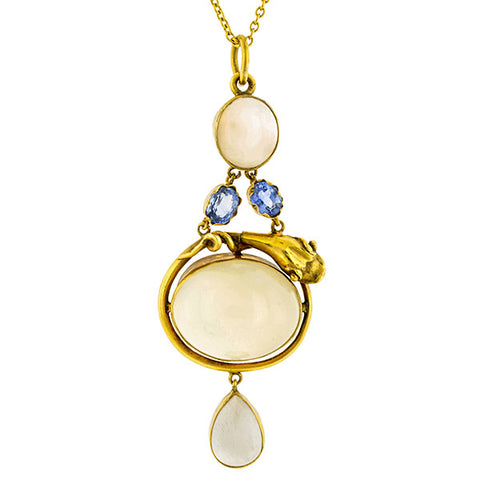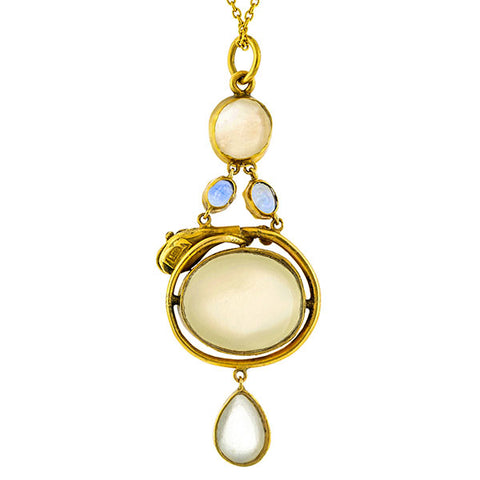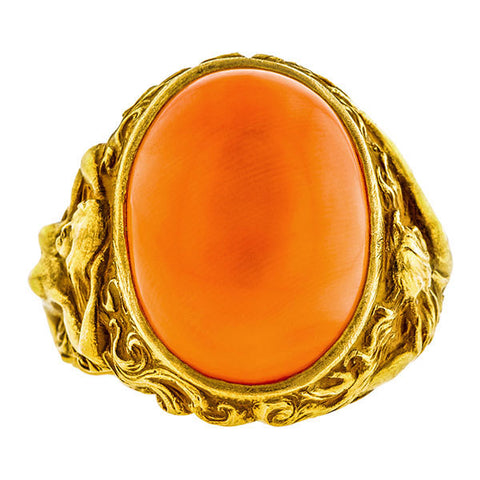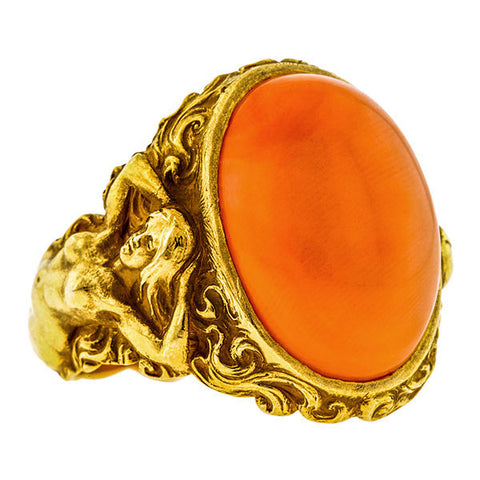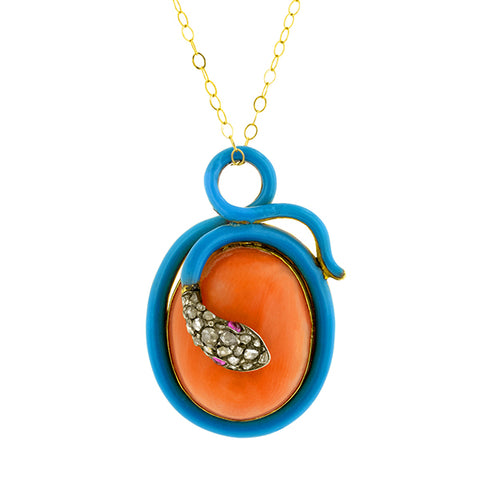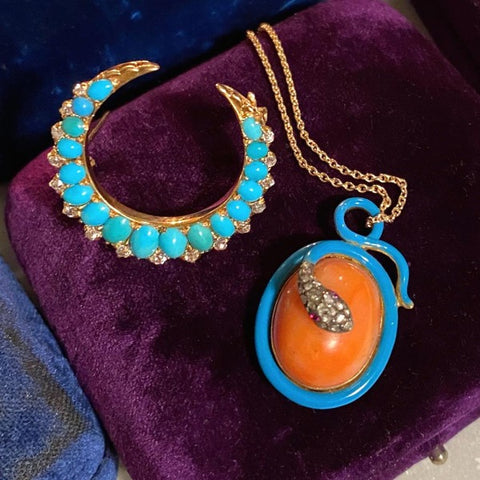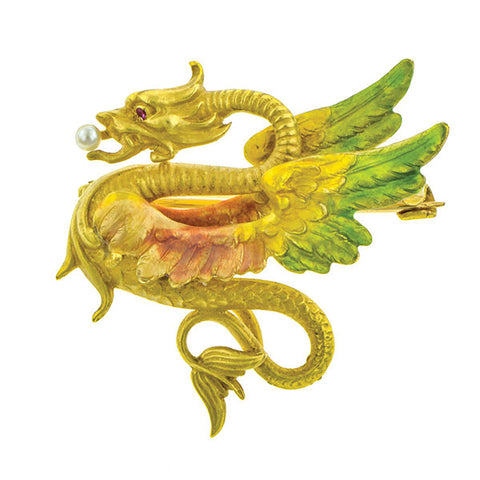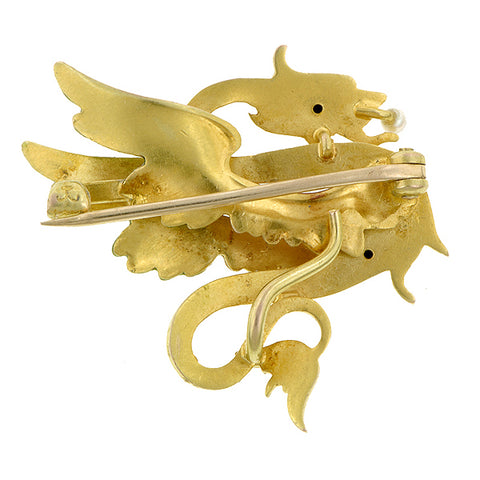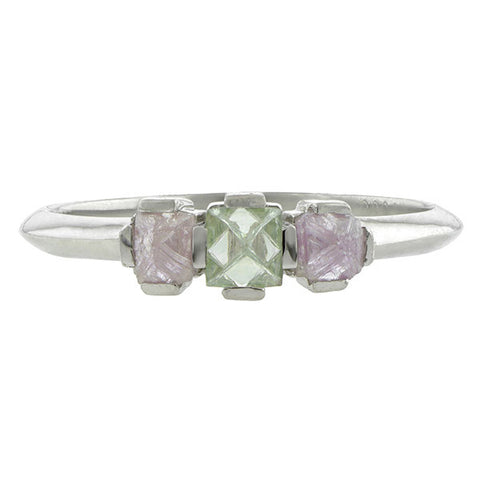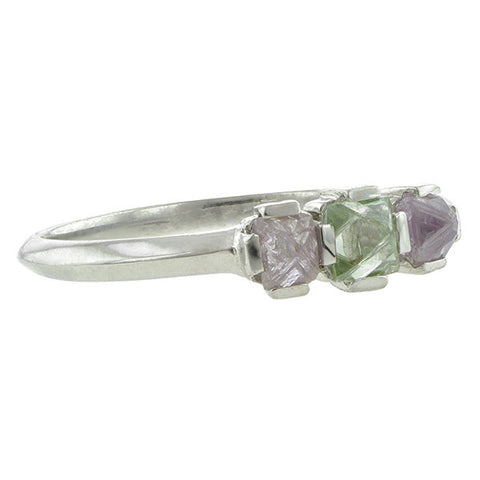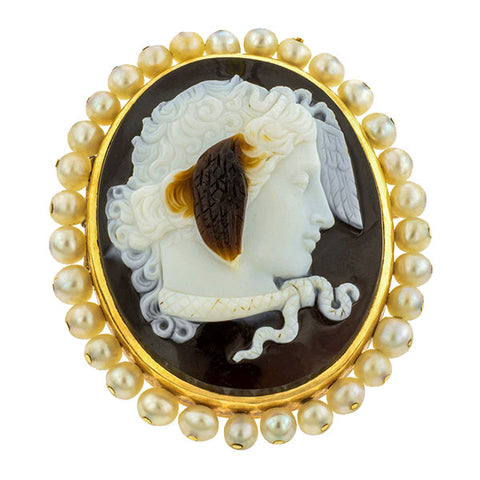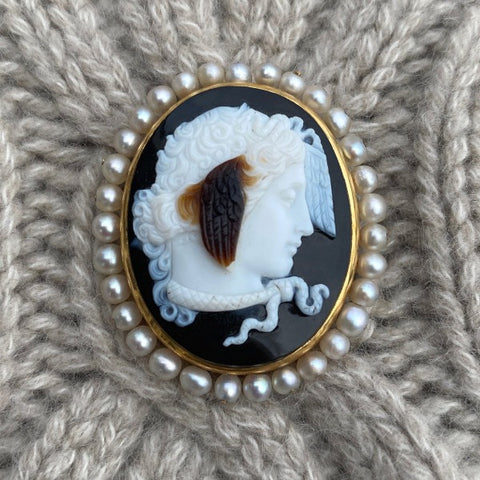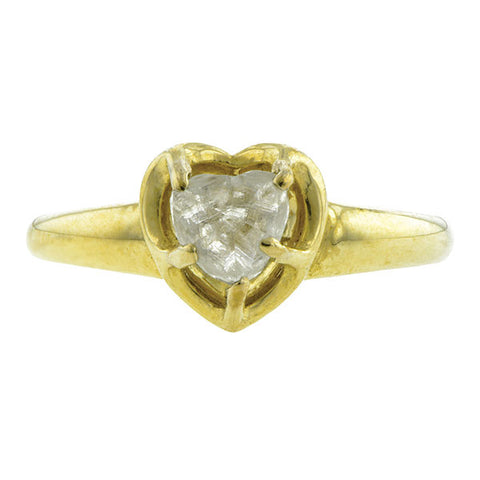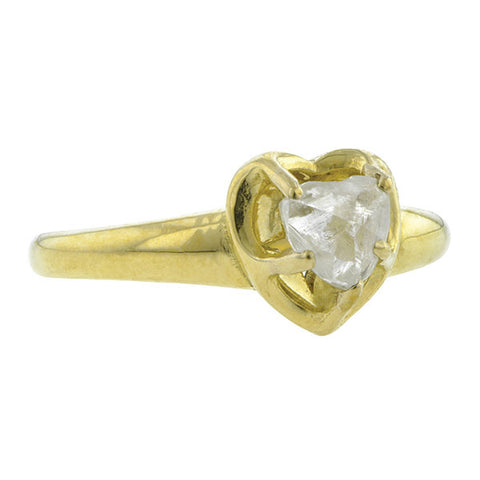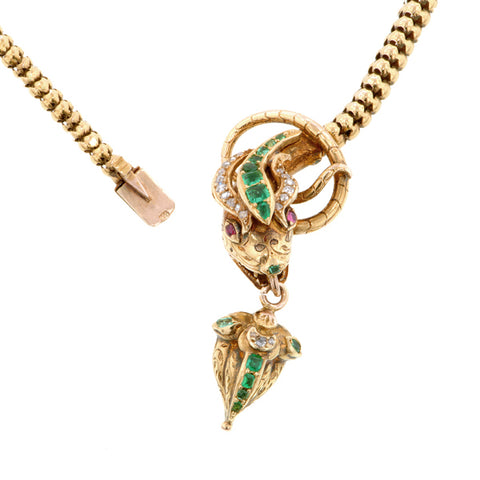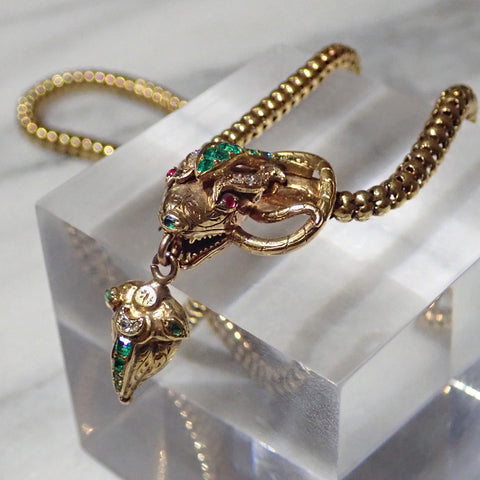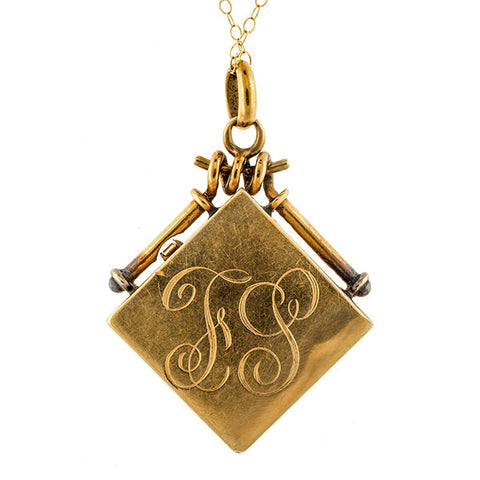Categories
Categories

The Vault is open! On view until October 28th, 2017 is our newest jewelry exhibition, Talismans: Amulets of Power and Protection. Delve into jewelry’s powerful symbols, shapes, and materials, such as snakes, dragons, crosses, and scarabs. The exhibition, curated by our own Elizabeth Doyle, includes antique, vintage, and contemporary pieces that go beyond beauty to give us insight into the personal reasons why we wear jewelry. Keep reading to see all forty one jeweled talismans, as well as Elizabeth’s research into their meanings.
An introduction from Elizabeth: Jewels have been worn as amulets for as long as jewelry has existed. Amulets are believed to have various powers; some protect the wearer from danger or evil, others bring good fortune, and some do both. Designed to be worn on the body, they travel with the owner, keeping their protection close at hand. Amulets are ascribed power from different aspects, including their material or form, or they can be imbued with power through a construct of man, usually a ceremony or ritual.
In all their different forms, amulets continue to have broad appeal. A quick survey of social media or fashion magazines will show amulets both old and new mixed with fashion of all kinds. Contemporary jewelers reinterpret amuletic materials and symbols to create new protective jewels. There is a universal appeal to a beautiful jewel that is a physical source of comfort and protection.

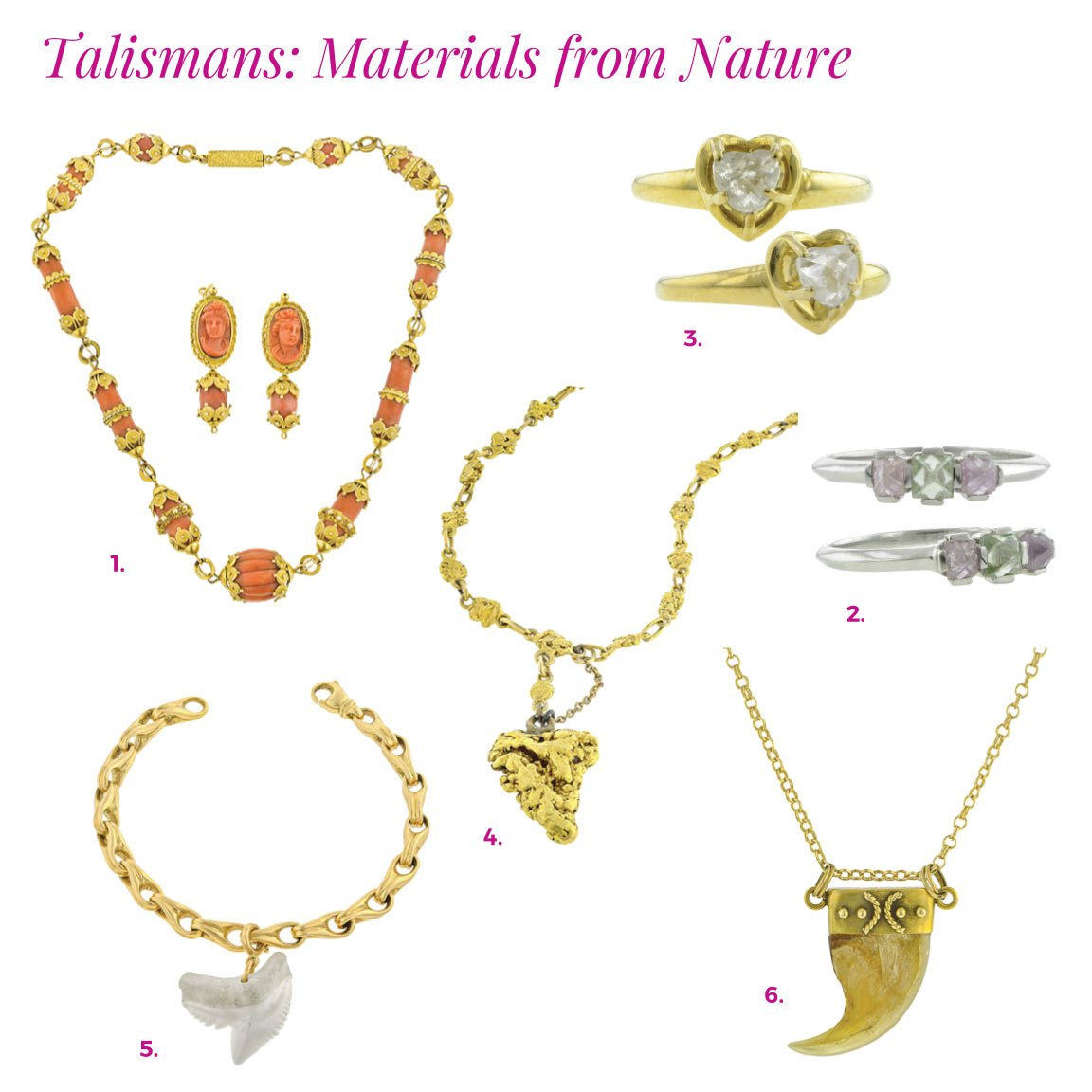
Materials from Nature
- Victorian Coral Necklace and Earrings, circa 1890. Carved and cylindrical coral bead necklace with intricate gold work, along with matching day to night earrings.
- Fancy Colored Octahedron Diamond Ring in platinum. Contemporary from Heirloom by Doyle & Doyle.
- Natural Heart-Shaped Diamond Crystal Ring in gold. Contemporary from Heirloom by Doyle & Doyle.
- Antique Gold Nugget Necklace, circa 1896. Formed of naturally occurring gold nuggets linked together to form a chain, suspending a larger natural nugget as a pendant.
- Shark’s Tooth Bracelet in gold. Circa 1960 on contemporary chain. Vintage shark’s tooth charm attached to a contemporary chain bracelet. The inspiration for the design is the loop in loop chain, one of the earliest types of chain. It was made as early as 3000 BC.
- Victorian Tiger’s Claw Pendant in gold, Circa 1880. With granulated and wire embellished cap.


Symbols from Nature
- Victorian Snake Necklace in gold, with emerald, diamond and ruby. Circa 1870. Designed as a snake encircling the wearer’s neck, suspending from the mouth a stylized heart drop with locket back.
- Victorian Coral Snake Pendant in gold, with coral, rose cut diamond and enamel. Circa 1840. An oval coral cabochon, framed by a blue enamel snake, with a pave set head covered with rose cut diamonds. In the Victorian era, both blue turquoise and blue enamel of this shade were associated with remembrance because of the color’s similarity to that of forget-me-not flowers.
- Victorian Snake Pendant in gold, with cat’s eye moonstone and sapphire. Circa 1880. An oval cat’s eye moonstone encircled by a gold snake, further embellished with sapphires and cat’s eye moonstones.
- Edwardian Snake Pin in gold and platinum, with pearl, diamond and tsavorite garnet. Circa 1910. A large baroque pearl framed by an undulating snake, with textured scales and embellished with foliate elements set with rose cut diamonds. Set at the head with a tsavorite garnet, a later replacement.
- Antique Scarab Pin in gold, with faience and diamond. Circa 1880. Centering a faience scarab with seal on the back. The seal features the cartouche of Thutmose IV along with other hieroglyphics including a winged sun disk. The scarab is set in a Victorian frame of Old Mine cut diamonds and topped with a diamond crown which seems to be a marriage from another antique jewel.
- Vintage Stylized Scarab Brooch in gold, with emerald and banded agate. Circa 1980. Carved emerald in the form of a stylized scarab, topped by a semicircle of banded agate carved in the form of teeth or claws. The overall effect gives the appearance of a figure with an elaborate headdress, almost sun-like.
- Art Nouveau Egyptian Revival Scarab Ring in gold, with lapis. Circa 1905. Centering a carved lapis scarab in a lightly scrolled fluted frame, tapering to open shoulders with a Hercules knot motif.
- Victorian Egyptian Revival Scarab Ring in gold, with faience. Circa 1890. Faience scarab with seal for the lion headed goddess Sekhmet, set into an oval bezel framed mounting with a rope motif. The wire work on the shoulders is reminiscent of ancient swivel ring styling.
- Art Nouveau Scarab Pendant necklace in gold, with nephrite (jade), diamond. Circa 1915. Bezel set carved translucent nephrite scarab, accented with an Old Mine cut diamond.
- Victorian Salamander Pin in gold, with diamond and emerald. Circa 1880. Pave set with Old European, Old Mine and rose cut diamonds, with bezel set emerald eyes.
- Victorian Salamander Bracelet in gold. Circa 1890. Bypass design centering a beautifully modeled salamander with variously textured skin.


Symbols from Mythology
- Vintage Dragon Necklace in white gold, with carved opal, diamond. Circa 1970. B. Anton, American. Carved opal in the form of Chinese dragons. Barbara Anton was an actress, playwright and novelist in addition to being an accomplished jeweler. She is known for her bold freeform jewelry designs and often used unusual stones or unexpected combinations of materials. Anton received 23 international awards for Excellence in Jewelry Design.
- Vintage Dragon Pin in gold, with jade and emerald. Chinese. Circa 1920. Designed as two entwined dragons encircling and clutching jade.
- Antique Enamel Dragon Pin in gold, with pearl and enamel. Circa 1905. Krementz, Newark, NJ. With translucent enamel wings graduating in color from pink to green. Krementz opened as Krementz & Company in 1869 in Newark, NJ. In 1884, they invented and patented a machine to produce one-piece collar buttons which was a major and important innovation at the time. But perhaps what they are best known for, and what is most sought after by collectors today, is the beautiful enamel jewelry they produced around the turn of the century.
- Antique Mermaid Intaglio Ring in gold, lapis. Circa 1920. Carved lapis intaglio depicting a mermaid admiring herself in a mirror.
- Art Nouveau Mermaid Ring in gold, coral. Circa 1900. Durand & Co, American. With two mermaids of differing poses on either side of the coral, their tails are entwined on the ring’s underside.
- Georgian Medusa Cameo Pin in gold, with carved banded agate cameo and pearl. Circa 1830. Medusa after a classical depiction.
- Medusa Drop Earrings, Heirloom by Doyle & Doyle in gold. Contemporary from Heirloom by Doyle & Doyle. Modeled after classical Medusas to display beauty and strength.
- Georgian Enamel Phoenix Locket in gold, with enamel, human hair and painted portrait. Circa 1830. Guilloche enamel backgrounds, upon which has been hand painted a phoenix on one side and a coat of arms on the other. The interior houses a hand painted miniature portrait opposite Prince of Wales hair plumes.


Symbols from Christianity
- Crucifix Enamel Pendant in gold, enamel. Portuguese. Circa 1940. Based on earlier cross designs from the 1600s, this cross is engraved & enameled with lines to refer to the original wooden cross. Applied gold tablet with INRI above the corpus, representing the Latin initials that translate to “Jesus the Nazarene, King of the Jews.” The bottom of the cross has an applied set of crossed bones to symbolize Golgotha, the site where Jesus was said to have been crucified, also known as the place of the skull. The back of the cross is engraved with a lance and a palm tree branch, the symbols of the crucifixion. The lance refers to Longinus, a Roman soldier who used a lance to test if Jesus was dead. The branch of palm represents Jesus entering Jerusalem on Palm Sunday on a donkey. His use of a donkey symbolized his arrival in peace, rather than on a horse as would a war-waging king.
- Georgian Diamond Cross in gold, with silver and rose cut diamonds. Circa 1830. Elaborate closed back cut down collet settings.
- Victorian Woven Hair Cross Pendant in gold, human hair. Circa 1840. With beautiful openwork plaits of hair. Human hair played an important role in jewelry of the Victorian era. It could be used as a sentimental or romantic gesture or as a memorial.
- Victorian Greek Cross Pendant/Locket in gold, turquoise. Circa 1870. Four engraved, triangular locket compartments.
- Vintage Virgin Mary Pendant in platinum, with mother of pearl, rose cut diamonds and seed pearls. Depicting our Lady of Fatima with Lúcia Santos and her cousins, Jacinta and Francisco Marto. In Fatima, Portugal in 1917, the three children claimed that angels and the Virgin Mary visited them on multiple occasions while they tended their sheep. Through these visitations, a number of miracles came to be recognized. A hundred years later, in 2017, Jacinta and Francisco Marto were canonized as saints by Pope Francis.


Symbols of Luck
- Vintage Charm Bracelet in gold, with enamel, clover. Assembled charms are circa 1650 to 1940. This bracelet includes a Lucky 13 horseshoe charm, a natural four leaf clover in a glass case, a pig carrying a four leaf clover that reverses to a roulette wheel on the other side, and a medieval ducat with Christian icons.
- Vintage Charm Bracelet in gold and enamel. Circa 1920. Eight enameled charms, including cards showing four aces (a winning hand) and a black cat.
- Antique Horseshoe Necklace in white and yellow gold, with cat’s eye chrysoberyl and Old Mine cut diamonds. Circa 1900. Cat’s eye chrysoberyl displays a phenomenon known as chatoyancy and has been used to ward off the evil eye.
- Victorian Horseshoe Locket in green and yellow gold. Circa 1890. Originally, this locket would have been worn as fob on a pocket watch chain.
- Late Victorian Horseshoe (sold) Pin in gold, sapphires. American. Circa 1900. Set with Montana sapphires.



Symbols of Protection and Unity
- Vintage Figa Charm (sold) in gold, rose quartz. Circa 1960. Rose quartz carved in the form of a closed hand. The Figa, or Mano Figa, represents a rude hand gesture. The thumb through the fingers symbolizes sexual union. It has been used since the Roman times, perhaps earlier, to ward off the evil eye.
- Georgian Gryllus Intaglio Ring in gold, glass. Circa 1830. Featuring a gryllus of two conjoined human heads, one bearded. The term gryllus, when used in reference to an intaglio or cameo, indicates a group of conjoined heads. They can be fantastical combinations of beasts and humans, multiple humans, or humans and animals. Often with mythological or magical associations, they are believed to protect the wearer from harm.
- Victorian Carnelian Seal Talon Fob in silver, with gold, carnelian. Circa 1860. Engraved “Vince Malum Bono” translating to “Defeat Evil with Good.”
- Crowned Double Heart Pin in gold, with black champlevé enamel and rose cut diamonds. Circa 1900. A brooch with two entwined hearts topped by a crown is often referred to as a Luckenbooth brooch. The name Luckenbooth comes from the stalls by St. Giles Cathedral in Edinburgh, Scotland where these brooches were sold in the 19th century. They are also known as witches’ brooches. The hearts symbolize love while crown symbolizes loyalty.
- Antique Fede Ring (sold) in gold. Early 20th century. Featuring two hands clasped. Arabic hallmarks. One mark reading “Eternity.” In Roman times, the design of two clasped hands was called dextrarum iunctio from Latin, meaning joined right hands, or Concordia, for Concord the goddess of harmony. She was known to provide marital harmony. In the Middle Ages, the symbol of clasped hands became known as fede, Italian for trust and fidelity.
- Georgian Seal Fob in gold, carnelian. Circa 1800. Engraved “L’Amour les Unit” translating to “Love Unites,” along with cupid holding flaming double hearts. The flaming hearts represent endless passionate love.


